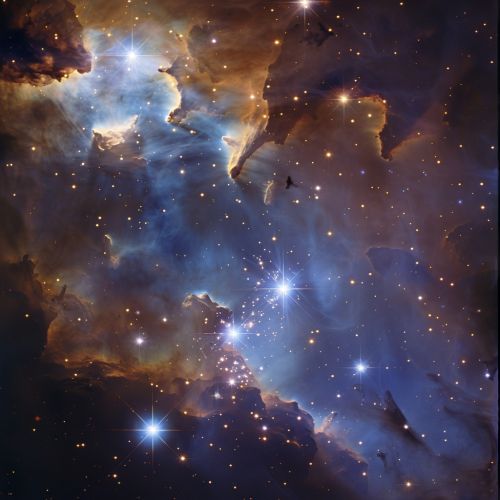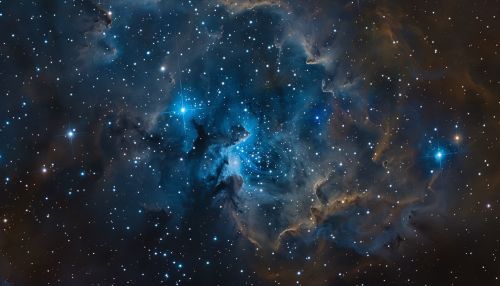Molecular Astrophysics
Introduction
Molecular astrophysics is a branch of astrophysics that studies the molecular components of the universe, including their formation, destruction, and interactions within various cosmic environments. This field combines principles from astronomy, chemistry, and physics to understand the role of molecules in space, from the interstellar medium to star-forming regions and beyond.
Historical Background
The origins of molecular astrophysics can be traced back to the discovery of interstellar molecules in the early 20th century. The identification of the CH radical in 1937 marked the beginning of molecular spectroscopy in space. Subsequent advancements in radio astronomy and infrared spectroscopy have significantly expanded our knowledge of molecular species in various cosmic environments.
Molecular Formation and Destruction
Molecular formation in space occurs primarily through gas-phase reactions and on the surfaces of interstellar dust grains. Key processes include:
Gas-Phase Reactions
In the gas phase, molecules form through ion-molecule reactions, neutral-neutral reactions, and radiative association. For example, the formation of H2 (molecular hydrogen) is a fundamental process that occurs via the reaction of hydrogen atoms on dust grain surfaces.
Surface Reactions
Surface reactions on dust grains are crucial for the formation of complex organic molecules. These grains provide a surface for atoms and molecules to adhere to, facilitating reactions that would otherwise be inefficient in the gas phase. For instance, the formation of methanol (CH3OH) involves hydrogenation of CO on grain surfaces.
Destruction Mechanisms
Molecular destruction in space can occur through photodissociation, cosmic ray interactions, and chemical reactions. Ultraviolet (UV) radiation from stars can break molecular bonds, leading to the dissociation of molecules such as CO and H2O.
Interstellar Medium
The interstellar medium (ISM) is a complex and dynamic environment where molecular astrophysics plays a pivotal role. The ISM consists of gas and dust, with molecular clouds being the densest and coldest regions, often serving as stellar nurseries.
Molecular Clouds
Molecular clouds are dense regions within the ISM where temperatures are low enough for molecules to form and survive. These clouds are primarily composed of H2 and are the birthplaces of new stars. The presence of molecules like CO, NH3, and H2O provides critical information about the physical conditions within these clouds.


Diffuse Clouds
Diffuse clouds are less dense than molecular clouds and are primarily composed of atomic hydrogen. Despite their lower density, these clouds contain a variety of molecules, including CH, CN, and C2, which can be detected through absorption spectroscopy.
Star Formation
Molecular astrophysics is integral to understanding star formation. The collapse of molecular clouds leads to the formation of protostars, which eventually evolve into main-sequence stars.
Protostellar Cores
Protostellar cores are dense regions within molecular clouds where star formation begins. These cores are rich in molecular species, and their chemical composition evolves as the core collapses and heats up. Observations of molecules like HCO+ and N2H+ provide insights into the dynamics of core collapse.
Protoplanetary Disks
Around young stars, protoplanetary disks form from the residual material of the molecular cloud. These disks are sites of planet formation and contain a rich inventory of molecules, including complex organic compounds. Studies of molecules like HCN and C2H2 in these disks help us understand the chemical processes that lead to planet formation.
Astrochemistry
Astrochemistry is a subfield of molecular astrophysics that focuses on the chemical processes occurring in space. It involves both observational and theoretical studies to understand the formation, destruction, and evolution of molecules in various cosmic environments.
Observational Astrochemistry
Observational astrochemistry relies on spectroscopy to detect and analyze molecular species in space. Instruments like the Atacama Large Millimeter/submillimeter Array (ALMA) and the James Webb Space Telescope (JWST) provide high-resolution spectra that reveal the presence of molecules in different astrophysical settings.
Theoretical Astrochemistry
Theoretical astrochemistry involves computational models and simulations to predict the behavior of molecules in space. These models help interpret observational data and provide insights into the chemical processes that occur in environments that are difficult to observe directly.
Molecular Spectroscopy
Molecular spectroscopy is a fundamental tool in molecular astrophysics. It involves the study of the interaction between electromagnetic radiation and molecules, providing information about molecular composition, structure, and dynamics.
Rotational Spectroscopy
Rotational spectroscopy measures the rotational transitions of molecules, typically in the microwave and millimeter-wave regions of the electromagnetic spectrum. This technique is particularly useful for detecting and analyzing diatomic and small polyatomic molecules in the ISM.
Vibrational Spectroscopy
Vibrational spectroscopy involves the study of vibrational transitions of molecules, usually in the infrared region. It provides information about the molecular bonds and the physical conditions of the environment. For example, the detection of vibrational transitions of H2O and CO2 in protoplanetary disks helps understand the thermal structure of these disks.
Electronic Spectroscopy
Electronic spectroscopy studies the electronic transitions of molecules, often in the ultraviolet and visible regions. This technique is essential for detecting molecules in high-energy environments, such as the vicinity of hot stars and active galactic nuclei.
Complex Organic Molecules
Complex organic molecules (COMs) are of particular interest in molecular astrophysics due to their potential role in the origin of life. These molecules, which include amino acids, sugars, and nucleobases, have been detected in various cosmic environments, from molecular clouds to comets.
Formation Mechanisms
The formation of COMs in space involves both gas-phase and surface reactions. On dust grains, simple molecules can undergo hydrogenation and other reactions to form more complex species. For example, the formation of glycine (NH2CH2COOH) may occur through the combination of simpler precursors on grain surfaces.
Detection and Analysis
The detection of COMs relies on high-resolution spectroscopy. Instruments like ALMA and JWST have identified numerous COMs in star-forming regions and protoplanetary disks. These observations provide insights into the chemical complexity of these environments and the potential for prebiotic chemistry.
Extragalactic Molecular Astrophysics
Molecular astrophysics is not limited to our galaxy; it extends to the study of molecular content in other galaxies. This field provides valuable information about the chemical evolution of galaxies and the conditions for star formation in different cosmic environments.
Molecular Gas in Galaxies
The study of molecular gas in galaxies involves observing molecular lines, such as CO, to trace the distribution and dynamics of molecular clouds. These observations reveal the star formation rates and the influence of galactic dynamics on molecular gas.
Active Galactic Nuclei
Active galactic nuclei (AGN) are regions at the centers of some galaxies with extremely energetic processes. The molecular gas in these regions can be affected by the intense radiation and outflows from the central supermassive black hole. Studies of molecules like HCN and HCO+ in AGN provide insights into the physical conditions and chemical processes in these extreme environments.
Future Prospects
The future of molecular astrophysics is promising, with advancements in observational technology and theoretical models. Upcoming missions and instruments, such as the Square Kilometre Array (SKA) and the Extremely Large Telescope (ELT), will provide unprecedented data on molecular processes in space.
Technological Advancements
Technological advancements in spectroscopy, such as higher sensitivity and resolution, will enable the detection of more complex molecules and the study of molecular processes in greater detail. These advancements will also facilitate the exploration of molecular content in distant and faint cosmic objects.
Interdisciplinary Research
Molecular astrophysics will continue to benefit from interdisciplinary research, combining expertise from chemistry, physics, and astronomy. Collaborative efforts will enhance our understanding of molecular processes in space and their implications for the broader field of astrophysics.
